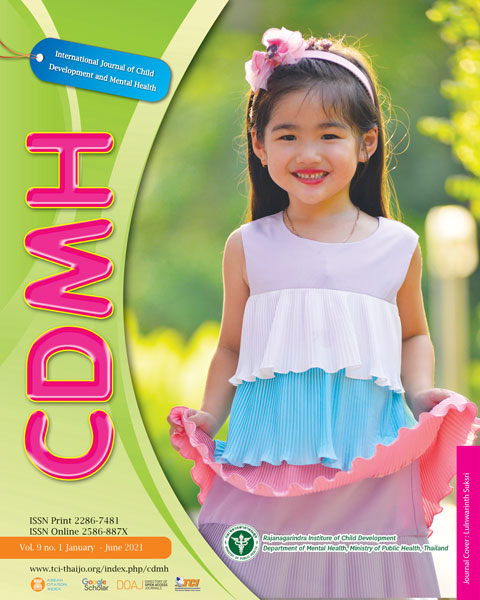Consonant Screening Application
Main Article Content
Abstract
The objectives of this study were to determine the content validity of the tool, ‘Application for Consonant Screening’ for normal children aged 2-3 ½ years old with and without cleft lip and palate (CLP). The procedures used in this study included 1) review of literature; 2) establishment of words, composition of initial consonants that were common defects in compensatory articulation disorders (CAD) for children with cleft lip and palate (CLP); 3) design the application; 4) develop the first version of Application for Consonant Screening; 5) Assess Index of Item Objective Congruence (IOC); 6) Tried out to find face validity in 7 children (5 normal and 2 children with CLP). The results showed that the Application for Consonant Screening had IOCs of technical and content agreements of 0.93 and 0.92, respectively. The study concluded that the Application for Consonant Screening could be used as an appropriate tool for articulation screening for children aged 2 - 3 ½ years old.
Article Details
![]()
Creative Commons License
This work is licensed under a Creative Commons Attribution-NonCommercial-No Derivatives 4.0 International (CC BY-NC-ND 4.0)
The authors retain copyright and permit the journal the copyright of first publication
Articles, once having passed the review process and accepted for publication in the CDMH Journal, are copyrighted under the CDMH Journal, Department of Mental Health, Ministry of Public Health. Please be aware distribution of CDMH Journal content for commercial purposes without permission is expressly prohibited. However, distribution with intent to educate, advocate, or spread awareness within the general public and research communities is permitted and encouraged with the understanding that the CDMH Journal Editorial Board do not hold jurisdiction or liability for any accompanying comments, text, or information from third parties, either in favor for or against the original article’s assertions, conclusions, methodology, or content.
References
กระทรวงศึกษาสาธารณสุข. (2546). คู่มือการฝึก
พูดเบื้องต้น. กรุงเทพมหานคร : กรม
สุขภาพจิตสถาบันราชานุกูล
_______. (2558). คู่มือประเมินและส่งเสริม
พัฒนาการเด็กกลุ่มเสี่ยง. กรุงเทพฯ:
สถาบันพัฒนาการเด็กราชนครินทร์
สำนักงานกองทุนสนับสนุนการสร้าง
เสริมสุขภาพ.
จักรกฤษ ศิริมังคโล. (2558). ผลสัมฤทธิ์ทางการเรียน
และลักษณะการใช้แอปพลิเคชันบนแท็บ
เล็ต วารสารวิชาการศึกษาศาสตร์ คณะ
ศึกษาศาสตร์ มหาวิทยาลัยศรีนครินทรวิ
โรฒ, 16(2), 82 – 90.
จักรชัย โสอินทร์, & พงษ์ศธร จันทร์ยอย. (2554).
Basic Android App Development.
กรุงเทพฯ : ไอดีซี พรีเมียร์ จำกัด.
จักรชัย โสอินทร์, พงษ์ศธร จันทร์ยอย, & ณัฐณิชา วี
ระมงคลเลิศ. (2555). คู่มือพัฒนาแอปพลิเค
ชันAndroid อย่างมืออาชีพ. กรุงเทพฯ : ไอดี
ซี พรีเมียร์ จำกัด
จิรภรณ์ อังวิทยาธร. (2560). เด็กกับเครื่องมือ
สื่อสารอิเล็กทรอนิกส์.ภาควิชาเภสัชเคมี
คณะเภสัชศาสตร์ มหาวิทยาลัยมหิดล.
เฉลิมชัย นิลสุวรรณโฆษิต, ปรางทิพย์ ศิริชื่นวิจิตร,
& วรพล บุญญบาล. (2559). การ
เปรียบเทียบ ระยะเวลาในการฝึกพูดให้
ชัดระหว่างการใช้แบบฝึกที่คำนึงถึงการ
ออกเสียงร่วมและแบบฝึกทั่วไปในเด็กที่
พูดไม่ชัด. วารสารการแพทย์รามาธิบดี,
39(4), 234 – 243.
ธานินทร์ ศิลป์จารุ. (2560). การวิจัยและวิเคราะห์
ข้อมูลทางสถิติด้วย SPSS แ ละ AMOS.
พิมพ์ครั้งที่ 17. กรุงเทพฯ : บิสซิเนสอาร์
แอนด์ดี.
เบญจมาศ พระธานี. (2554). การสอนพูดและการ
รักษาบำบัดแบบสหสาขาวิทยาการ
(ออทิซึม). ขอนแก่น : คณะแพทย์ศาสตร์
มหาวิทยาลัยขอนแก่น.
เบญจมาศ พระธานี. (2557). ปากแหว่งเพดานโหว่
ปัญหาทางการพูดและการรักษาแบบสห
สาขาวิชาชีพเล่ม 1. ขอนแก่น:คณะแพทย์
ศาสตร์ มหาวิทยาลัยขอนแก่น.
เบญจมาศ พระธานี. (2557). ปากแหว่งเพดานโหว่
ปัญหาทางการพูดและการรักษาแบบสห
สาขาวิชาชีพเล่ม 2. ขอนแก่น:คณะแพทย์
ศาสตร์ มหาวิทยาลัยขอนแก่น.
ประพฤทธิ์ จิตรรุ่งวิทยา. (2557). การพัฒนาสื่อการ
สอนทักษะการสื่อสารของเด็กออทิสติก.
คณะเทคโนโลยีสารสนเทศ มหาวิทยาลัย
เทคโนโลยีพระจอมเกล้าพระนครเหนือ.
พวงรัตน์ ทวีรัตน์. (2543). วิธีการวิจัยทาง
พฤติกรรมศาสตร์และสังคมศาสตร์.พิมพ์
ครั้งที่ 8 กรุงเทพฯ:ศูนย์หนังสือจุฬาลง
กรณ์.
ภมิตา ปุรณะพรรค์. (2559). แอปพลิเคชันเกมบน
แอนดรอยด์เพื่อพัฒนาประสาทสัมผัส
สำหรับเด็กออทิซึมในช่วงวัย 6 – 12 ปี.
การค้นคว้าอิสระปริญญาวิทยาศาสตร
มหาบัณฑิต สาขาวิชาวิศวกรรมซอฟต์แวร์
บัณฑิตวิทยาลัย มหาวิทยาลัยเชียงใหม่.
รวีพร จรูญพันธ์เกษม. (2561). การพัฒนารูปแบบการ
สอนโดยอาศัยแอปพลิเคชันการอ่านออก
เสียงด้วยระบบรู้จำเสียงพูดและเกมทาย
คำศัพท์ภาษาอังกฤษ. วารสารวิทยาศาสตร์
และเทคโนโลยีหัวเฉียวเฉลิมพระเกียรติ,
4(1), 56 - 68.
สุทิน ชนะบุญ. (2550). การวิเคราะห์ข้อมูลใน
งานวิจัยเบื้องต้นโดยใช้โปรแกรม SPSS
For windows.ขอนแก่น:วิทยาลัยการ
สาธารณสุขสิรินธร.
Great Ormond Street Hospital (2016). Speech
and Language Department (from
birth to 12 months). England:London.
Jenny S. Radesky, et al. (2016). Overstimulated
Consumers or Next-Generation
Learners? Parent Tensions About Child
Mobile Technology Use. Annals of
Family Medicine,14(6), 503 – 508.
Lauren J. Myers, Rachel B. LeWitt, Renee E.
Gallo & Nicole M. Maselli. (2017).
Baby Face Time: can toddlers learn from
online video chat.Developmental
Science, 20(4)
Liraz Margalit Ph.D.(2016) ,What Screen Time
Can Really Do to Kids' Brains. from
https://www.psychologytoday.com/us/b
log/behind-online-behavior/201604/
what-screen-time-can-really-do-kids-
brains?page=1.
María del Carmen Pamplona, Pablo Antonio Ysunza
& Santiago Morales. (2016). Audiovisual
materials are effective for enhancing the
correction of articulation disorders in
children with cleft palate. 17 – 23.
Peterson - Falzone SJ, Hardin-Jones MA, Karnell
MP. Cleft palate speech. 4th ed. St.
Louis: Mosby Elsevier; 2010.
Prathanee B, Thanawiratananit P,
Thanawiratananit S. (2013). Speech,
Language, Voice, Resonance and
Hearing Disorders in Patients with Cleft
Lip and Palate. J Med Assoc Thai, 95
Suppl.11:S71-80.
Prathanee B, Suzanne C Purdy, Bandit
Thinkhamrop, Bhunyabhadh Chaimay,
Nitchara Ruangdaraganon, Ladda Mo-
suwan, & Rutja Phuphaibul. (2009).
Early Language Delay and Predictive
Factors in Children Aged 2 Years. J
Med Assoc Thai, 92(7), 930 - 938.
Prathanee B. (2006). Factors affecting
specific language impairment : effect
on later language development. Khon
Kean, Graduate School, Khon Kean
University.

